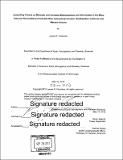| dc.contributor.advisor | Oliver Jagoutz. | en_US |
| dc.contributor.author | Pershken, James R | en_US |
| dc.contributor.other | Massachusetts Institute of Technology. Department of Earth, Atmospheric, and Planetary Sciences. | en_US |
| dc.coverage.spatial | n-us-ca n-us-az | en_US |
| dc.date.accessioned | 2018-03-12T19:30:46Z | |
| dc.date.available | 2018-03-12T19:30:46Z | |
| dc.date.copyright | 2015 | en_US |
| dc.date.issued | 2015 | en_US |
| dc.identifier.uri | http://hdl.handle.net/1721.1/114121 | |
| dc.description | Thesis: S.B., Massachusetts Institute of Technology, Department of Earth, Atmospheric, and Planetary Sciences, 2015. | en_US |
| dc.description | Cataloged from PDF version of thesis. | en_US |
| dc.description | Includes bibliographical references (pages 40-46). | en_US |
| dc.description.abstract | The Maria Fold and Thrust Belt (MFTB) and Colorado River Extensional Corridor (CREC) were the sites of atypically extreme compression in Mesozoic time and extension in Cenozoic time, respectively. The orientations of these deformational structures are at odds with the Sevier and Laramide thrust belts and the Basin and Range Extensional Province surrounding these areas, a fact that remains largely unexplained. Data pertaining to metamorphic grade, deformational structures, and plutonism are compiled and reported in order to characterize compression and metamorphism. Field data on the 18.6 Ma Peach Spring Tuff are collected and presented and data on cooling ages are compiled in order to characterize extension. It is suggested that high metamorphic temperatures and ductile compressional structures are related to Late Cretaceous S-type plutonism; furthermore, it is suggested that later extension is related to earlier metamorphism and compression. It is demonstrated that the spread in attitudes of the Peach Spring Tuff correlates well with the degree of post- 18.6 Ma extension. Finally, a favored model is presented for the Mesozoic-Cenozoic evolution of the MFTB and CREC. | en_US |
| dc.description.statementofresponsibility | by James R. Pershken. | en_US |
| dc.format.extent | 46 pages | en_US |
| dc.language.iso | eng | en_US |
| dc.publisher | Massachusetts Institute of Technology | en_US |
| dc.rights | MIT theses are protected by copyright. They may be viewed, downloaded, or printed from this source but further reproduction or distribution in any format is prohibited without written permission. | en_US |
| dc.rights.uri | http://dspace.mit.edu/handle/1721.1/7582 | en_US |
| dc.subject | Earth, Atmospheric, and Planetary Sciences. | en_US |
| dc.title | Controlling factors on Mesozoic and Cenozoic metamorphism and deformation in the Maria Fold and Thrust Belt and Colorado River Extensional Corridor, Southeastern California and Western Arizona | en_US |
| dc.type | Thesis | en_US |
| dc.description.degree | S.B. | en_US |
| dc.contributor.department | Massachusetts Institute of Technology. Department of Earth, Atmospheric, and Planetary Sciences | |
| dc.identifier.oclc | 1027708480 | en_US |
